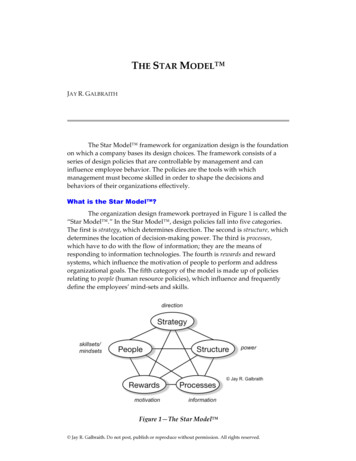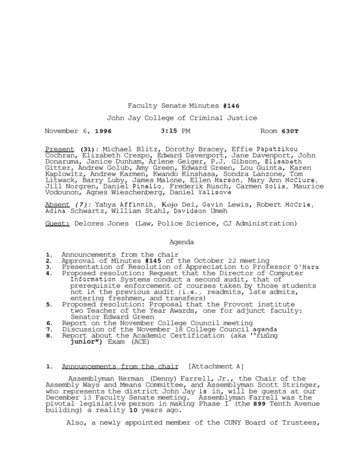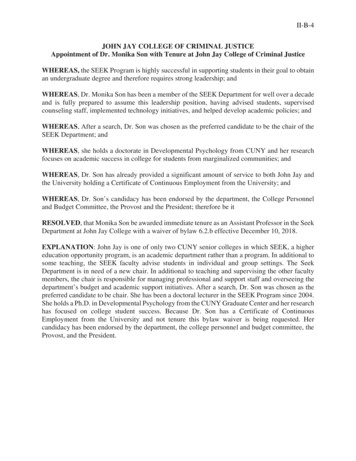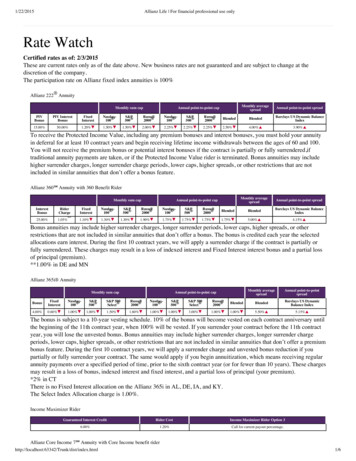
Transcription
Jay Soloff’s 10 Simple Rules For TradingOptions Like A Pro1
Jay Soloff’s 10 Simple Rules For Trading Options Like A ProJay Soloff’s 10 Simple Rules For Trading Options Like A ProThe explosion in popularity in options trading is undeniable. According to the OptionClearing Corporation (the largest US clearing firm for options contracts), over 4 billionoption contracts have traded every year since 2011. As a point of reference, the 1 billionmark hadn’t even been crossed until 2004. Clearly, options trading has caught on in a bigway.And it really shouldn’t be a surprise if you understand the benefits of options over stocksor other investment assets. Here are some of the most important benefits of options: Leverage (100 to 1 versus stocks) Defined risk Flexibility (Easy to go long or short options) Liquid marketsWith options, traders and investors can custom create strategies to fit their needs - froman income, return, or risk management standpoint (just to name a few). However, manyactive investors avoid options because they don’t understand their value or think theyare too complex.The truth is, option trading doesn’t have to be any more complex than trading stocks,bonds, or mutual funds. There are just a few rules you should know which can make allthe difference between successful options traders and those who lose money and quit.Knowing these rules - the secrets of options insiders - is how you can easily tell thedifference between savvy traders and those who just pretend to be experts.1
Jay Soloff’s 10 Simple Rules For Trading Options Like A ProSo without further ado, let’s get into the 10 secret rules of options insiders Secrets of Options SellingIf you spend any length of time learning about or trading options, you’ll inevitably hearthe phrase “you need to sell options to make money” or something similar. Generallyspeaking, this is a true statement. Selling options is a higher probability trade than buyingoptions.But as you may have guessed, it’s a bit more complex than just selling any old option youfind and expecting to make money. So, here are the keys to consistently and profitablyselling options: Sell options that are out-of-the-money: The reason selling out-of-the-moneyoptions (options that are not at or favorably beyond the underlying asset price) isa higher probability scenario than buying options is because of time to expiration.Options are expiring contracts, and as they get closer to expiration, their valuedecreases (all else being equal) and you collect that money. Most of the time when you buy out-the-money options, they expire worthless.Out-of-the-money options are used for hedging or low probability speculation –you want to be the one collecting money for those types of options, not buyingthem yourself. Don’t sell options that are too far out-of-the-money: While selling out-of-themoney options is generally a good idea, you don’t want to get too far away fromthe underlying asset price. For instance, an option that has roughly 1% chance offinishing in-the-money may seem like a great one to sell. But, for the smallamount of premium (price) you will collect, it isn’t worth the risk. Rather, sell a10%-20% probability option and collect a higher credit, while still keeping risk atreasonable levels. Sell options with about 30-45 days to expiration: This is a guideline more than arule because it often depends on what options months are available to trade. Thekey is you don’t won’t to go too close to expiration because there’s generally notenough premium (price) in the options to make them worth selling.2
Jay Soloff’s 10 Simple Rules For Trading Options Like A ProYou also don’t want to go too far out because there’s more event risk as youincrease the time you’re holding your short options. Don’t be afraid to close for a profit: You can use this rule for just about anyinvestment, of course. But, just because you’re dealing with high probabilitytrading doesn’t mean you shouldn’t set exit points for yourself. You don’t need toeke out every penny from your trades. When you hit a reasonable exit level, getout. Close your losers when the credit received is gone: You want to have patiencewhen selling options, but not too much patience. As a general rule of thumb, Iusually close losing positions when all my credit has evaporated. For example, ifyou sell an option for 1, if that option is now worth 2, I’ve lost an amount equalto my credit and I close it. Remember, you want the value of the option to go tozero when you’re the seller.Secrets of Options BuyingOne thing you don’t often hear when learning how to trade options is when to buyoptions. So many “experts” are focused on selling options, they make it seem like there’snever a good time to go long options (except for hedging of course). While selling optionsis certainly a much higher probability situation, it’s demonstrably false that you shouldalways avoid buying options.Like any other tradable asset, options can be expensive or cheap relative to their history.And, when options are cheap, it sometimes makes sense to buy them. Here are someimportant tips to consider when buying options: Don’t buy lottery tickets: You may see an option for 0.05 or even 0.25 and thinkof how much money you would make if you buy a bunch of those and theunderlying asset moves in your favor. There’s a reason why those options are socheap. They’re almost certainly going to expire worthless. Spend money to buytime/money-ness, and don’t waste cash on lottery tickets. Don’t pay too much: At the same time, you don’t want to spend a fortune on anoption which has an expiration date.3
Jay Soloff’s 10 Simple Rules For Trading Options Like A ProTime is against you when you own options, so I generally don’t like to spend morethan 1 per option, maybe 1.50 at most. Use vertical spreads: A vertical spread is when you buy an option close to thestrike price (the price of the underlying asset) and sell one farther away to reducethe cost of the trade. It caps the amount you can make on the trade, but cansignificantly lower the risk too. I almost always choose vertical spreads whenmaking directional trades. Use straddles or strangles: Why choose a direction for the underlying asset whenyou can make money if it moves either way? Sometimes you may believe an assetprice is going to move, but you aren’t sure which direction. Buying options makesthis a moot point as you can buy a straddle (buying the at-the-money call and putat the same time) or a strangle (buying an out-of-the-money call and put at thesame time), which can make money in either direction. Just make sure you don’tbreak the bank in order to do so. Don’t be afraid to take profits: It may seem exciting to earn 300% gains on a trade– which is very plausible when buying options. But, don’t miss out on a great tradein order to earn massive returns. Taking 100% profits is great. Heck, taking 30%profits is wonderful. When’s the last time your index fund did that?And there you have it. That’s 10 simple rules for trading like an options insider. We talkedabout five rules for selling options like a pro and five rules for savvy options buyers.Remember, selling options is a higher probability trade, while buying options cangenerate the biggest returns. Both buying and selling can be advantageous strategies, nomatter your experience level with options trading.Jay SoloffEditorOptions Profit Engine4
Jay Soloff’s 10 Simple Rules For Trading Options Like A Pro 2020 Investors Alley Corp. All rights reserved. Any reproduction, copying, or redistribution, in whole or in part, is prohibited without writtenpermission from Investors Alley Corp., 555 W 5th St, Floor 35, Los Angeles, CA 90013 10010 or www.investorsalley.com.Information contained in this email and websites maintained by Investors Alley Corp. ("Investors Alley") are provided for educationalpurposes only and are neither an offer nor a recommendation to buy or sell any security, options on equities, or cryptocurren cy.Investors Alley and its affiliates may hold a position in any of the com panies mentioned. Investors Alley is neither a registeredinvestment adviser nor a broker-dealer and does not provide customized or personalized recommendations. Any one-on-one coachingor similar products or services offered by or through Investors Alley does not provide or constitute personal advice, does not take intoconsideration and is not based on the unique or specific needs, objectives or financial circumstances of any person, and is i ntended foreducational purposes only. Past performance is not necessarily indicative of future results. No trading strategy is risk free. Tradingand investing involve substantial risk, and you may lose the entire amount of your principal investment or more. You should trade orinvest only "risk capital" - money you can afford to lose. Trading and investing is not appropriate for everyone. We urge you toconduct your own research and due diligence and obtain professional advice from your personal financial adviser or investment brokerbefore making any investment decision.For complete terms and conditions governing the use of this publication please visit www.investorsalley.com.5
Jay Soloff’s 10 Simple Rules For Trading Options Like A Pro The explosion in popularity in options trading is undeniable. According to the Option Clearing Corporation (the largest US clearing firm for options contracts), over 4 billion option contracts have traded every










